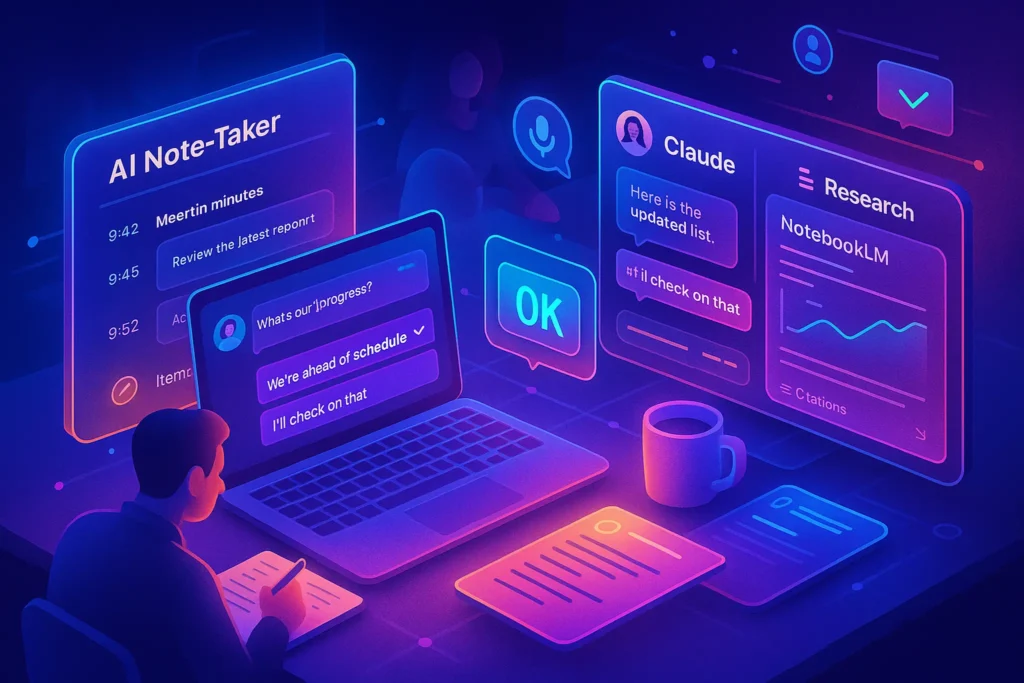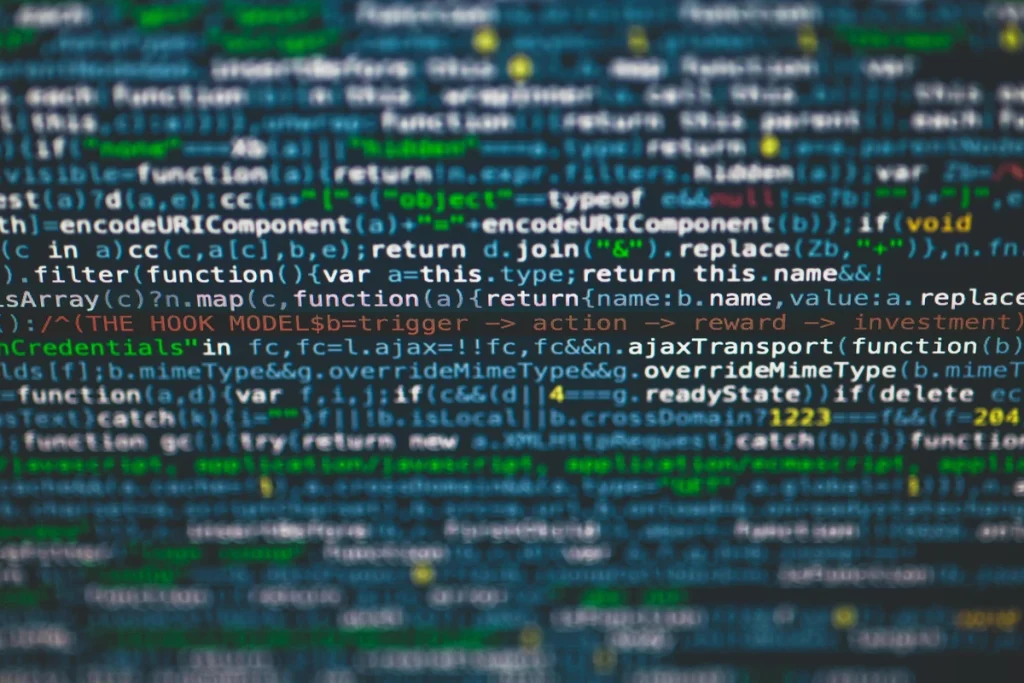-This post may contain affiliate links. If you click on one and make a purchase, I may earn a small commission at no extra cost to you.-
🧠 Introduction: The Year of Smarter Workflows
In 2025, AI isn’t just a buzzword—it’s reshaping daily workflows. From meeting transcription to proactive chatbots initiating conversations, AI is moving from passive assistant to active collaborator. In this guide, you’ll get an insider overview of the must-know AI tools that are shaping digital productivity. Whether you’re a student, freelancer, team lead, or creator, these tools will help you work smarter, not harder.
📝 AI Note-Takers: Capture Without Distraction
AI-powered note-taking tools are now essential for anyone who attends meetings or virtual events. Gone are the days of frantic transcription—the future is streaming summaries directly to you.
Jamie AI
Jamie AI delivers near-perfect transcription and insightful summaries across multiple platforms and languages. This tool doesn’t just capture—it categorizes key points and action items. A recent test ranked it among the top note-takers in 2025.
Otter.ai & Fireflies.ai
These two dominate collaboration workflows. Otter.ai offers real-time transcripts, automatic speaker identification, and collaborative editing. Fireflies integrates with Zoom/Teams and creates searchable databases of all your meetings—with features like sentiment analysis and task extraction.
Fellow & MeetGeek
Fellow focuses on team growth with actionable agendas and OKR tracking, while MeetGeek excels in structured meeting outputs.
Why it matters: AI note-takers let you focus on the conversation—not the keyboard. You retain fuller context, walk away with clear action points, and avoid meeting fatigue.
💬 Chatbots That Think Before You Do
AI chatbots are evolving from reactive Q&A helpers to proactive assistants that can initiate meaningful conversations.
Meta’s AI Studio / Project Omni
Meta is training its chatbots to reach out first—offering follow-ups or friendly check-ins after engaging with users. Use cases range from wellness reminders to customer check-ins.
Google Gemini
Embedded in workspace apps, Gemini shines in tasks like drafting professional emails and researching data. Tests on Pixel devices show it outperforming alternatives for concise business communication.
Anthropic’s Claude
Known for its ethical and calm communication style, Claude handles prompts with a “constitutional” focus—ideal for privacy-conscious work.
Perplexity, Grok, DeepSeek
Perplexity prioritizes source citing in research workflows. Grok (from xAI/X) brings personality and real-time X integration, and DeepSeek offers high reasoning power with efficient energy use.
These chatbots are not just reactive—they’re anticipatory. They suggest ideas, flag oversights, and can maintain long-running conversations.
🎓 AI Study & Co-Pilot Tools
Google NotebookLM
Now part of Google Workspace, NotebookLM reads your documents and delivers summaries, AI-generated quizzes, and even audio overviews. Great for students or researchers looking for guided understanding without digging through PDFs.
Lumio AI
An all-in-one AI workspace launched in 2025, Lumio lets you run multiple LLMs (ChatGPT, Gemini, Claude, etc.) simultaneously—ideal for comparing output before choosing the right one.
🤖 Autonomous Task AI
Manus
A breakthrough AI agent that can independently perform complex tasks—like writing and deploying code—without ongoing human guidance.
As AI agents grow more autonomous, they’re evolving into digital team members—capable of executing and reflecting on tasks with minimal oversight.
🤝 Ethical AI Companions
Portola’s Tolan
This new breed of “ethical AI companion” is designed to discourage overuse and support mental wellness. It’s more like a digital coach than a chatbot—and a necessary counterpoint to addiction-prone tools.
🧠 How to Choose the Right AI Tool
-
Know your primary need: transcribe, co-write, research, or automate.
-
Match to your workflow: students benefit from NotebookLM; professionals from Fireflies.
-
Consider privacy & cost: Claude for sensitive data; Omni for engagement bots.
-
Trial Before You Commit: Many tools offer generous free tiers—test before investing.
These tools don’t just automate—they accelerate cognition, focus, and creativity.
Don’t forget to check our guide on Best AI Tools for Freelancers to Save Time and Get Paid Faster for workflow-specific mix-ins.
Also, explore 10 Best AI Chrome Extensions That Save You Time Every Day—some clip into chatbots and note-takers seamlessly.
🧠 Proactive AI Chatbots: From Reactive to Anticipating
AI chatbots are evolving—not only responding, but initiating useful conversations. Meta’s Project Omni (via its AI Studio) is leading the charge. According to internal docs, these bots will proactively message users within two weeks of an initial chat—only after at least five prior exchanges—and only one follow-up per conversation.
Imagine the possibilities: you ask your “Workout Buddy” about yesterday’s routine, and it responds with “Hey! Ready for your week’s recovery stretch routine?” or “Want new workout music?” That’s contextual follow-up done right.
Meta currently trains these bots to:
-
Refer to previous details (e.g., “How’s your project going?”)
-
Follow strict tone and positivity guidelines
-
Not spam; follow-ups stop if no reply
This tech marks a shift from transactional bots to relationship-building assistants—helping with reminders, check-ins, and personalized insights. But there are trade-offs: some worry bots may feel intrusive . Use this approach thoughtfully—for personal coaching, mental wellness, or service follow-ups.
🤖 Autonomous AI Agents: Your Digital Teammates
Welcome to the era of true autonomy. Moving beyond chatbots, 2025 is seeing AI agents that not only talk but execute on your behalf.
🧞 OpenAI Operator
Launched Jan 2025, this browser-based agent can autonomously perform tasks like grocery ordering, expense report submissions, and appointment bookings. It doesn’t just draft responses—it interacts with forms and web apps in real-time, scraping data and completing steps without continual prompts.
📦 Manus AI
Introduced in March 2025 by Monica, Manus takes it further—designed to translate high-level intent into multistep workflows, including code deployment. This level of cognitive + executional capability is a watershed: asking an agent to “launch my new newsletter workflow” becomes feasible.
⚙️ AutoGPT & Agentic Systems
Open-source projects like AutoGPT pioneered this concept—chaining tasks, pulling from the web, and operating without user input—though early versions sometimes spiral into loops. Mix AutoGPT with enterprise-grade co-pilots like Operator or Manus and you’re building an AI digital staff member.
Companies like ServiceNow and Salesforce are overlaying intelligent agents that draft support replies, schedule meetings, and process invoices—augmenting human teams and cutting repetitive work.
Pro Tip: To benefit, define clear “agent roles” (newsletter manager, research assistant, CRM updater). Start small, watch logs, and scale with confidence—and governance.
📚 AI Note-Takers & Meeting Intelligence: The Rise of Invisible Scribes
AI note-takers have taken over. As of July 2025, tools like Otter.ai and Fireflies are so widespread they’re reshaping meeting dynamics. Many professionals now skip meetings, letting bots attend on their behalf.
Newcomers like Bluedot prioritize accuracy and privacy: it works quietly in the background (no visible “bot”), transcribing meetings in over 100 languages, identifying speakers, and highlighting action items. It’s ideal for teams with privacy requirements—recording sensitive meetings without disrupting them.
Publications say this boom is hitting tipping point: AI agents are outnumbering humans in virtual rooms. But it raises thorny issues around consent and etiquette.
Best practices for use:
-
Always state you’re recording
-
Store transcripts securely—not on default drives
-
Summarize and circulate action items quickly
🧩 How to Choose & Integrate the Right Tools
With so much innovation, let’s streamline your toolkit strategy—based on use-case and comfort:
| Use case | Recommended Tools |
|---|---|
| Conversational assistants | Gemini, Claude, Meta AI Studio (Proactive bots) |
| Autonomous execution | Operator, Manus, AutoGPT (start small workflows) |
| Meeting capturing | Otter.ai, Fireflies.ai, Bluedot (privacy-aware note-taking) |
| Research & cognition | Perplexity, NotebookLM, DeepSeek – for memory, summaries, & insight layering |
🧩 Starter Setup (For Busy Pros)
-
Choose one note-taker (e.g., Otter or Bluedot)
-
Build a proactive reminder bot (Project Omni)
-
Start one simple AI agent flow (e.g., order summary via Operator)
-
Review monthly—expand or refine tools as needed
✅ Alignment with Your Workflow
-
Students → Focus on NotebookLM, Perplexity for research
-
Teams → Use structured note-taking (Fellow), Omni re-engagement bots
-
Entrepreneurs → Deploy Operator + Manus for recurring admin tasks
🤔 Ethical & Productivity Considerations
Emerging AI has transformational potential—but also risks:
-
Privacy & consent: Check laws before transcribing meetings; record only with permission
-
Attention management: Proactive bots must add value, not buzz like Slack spam
-
Dependency risk: Ground automation in regular audits—don’t expect agents to be infallible
-
Data security: Store transcripts and agent logs securely—especially health, legal, or client data
❓ FAQ
Q: Is AI note-taking safe and compliant?
A: It depends. Tools like Otter.ai and Fireflies offer enterprise compliance features. Always check organizational policies and consent for recording.
Q: Which AI chatbot is best for productivity?
A: It depends: ChatGPT is versatile; Gemini excels in professional tone; Claude is privacy-conscious and calm in communication.
Q: Do intelligent chatbots invade my time?
A: Tools like Project Omni are built with user engagement limits (e.g., only proactive after five prior interactions).
Q: How often will proactive bots message me?
A: Project Omni bots only follow up once per thread, within 14 days, and only after you’ve interacted with them at least 5 times.
Q: Are autonomous agents trustworthy?
A: They’re promising, but need guardrails. Start with low-risk tasks (forms, ordering), monitor logs, and gradually scale.
🧠 Nerd Verdict
2025 is the year AI stops being reactive and starts being proactive—from capturing your ideas to anticipating your needs. By building a toolkit that includes note-taking, research, proactive chatbots, autonomous agents, and ethical companions, you create a cognitive tech stack—not just a toolset.
2025 marks the transition from passive AI tools to active AI partners—bots that attend meetings for you, agents that automate workflows, and assistants that remember and follow through. Embrace them smartly, align them with your objectives, and watch mundane work melt away. But ensure consent, oversight, and human control remain at the core.
💬 Would You Bite?
Which of these tool categories—meeting AI, proactive chatbots, autonomous agents—do you need most right now?
Drop your thoughts. I reply personally and curate the best toolkits for readers.👇



